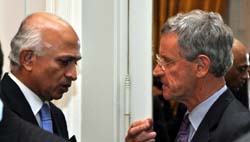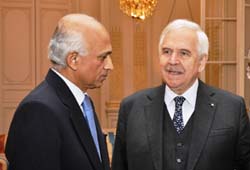 |
| H.E. Mr Ranjan Mathai with OIV President, Mr. Yves Bénard |
The credit for making the entry smoothly and with unanimity goes to the career diplomat H. E. Ranjan Mathai, India’s ambassador to France, who is credited by OIV as the ‘key person for promoting the adhesion to OIV.’ Mr Mathai worked relentlessly after the Ministry of Food Processing industries showed a strong desire to join the organisation after a thorough analysis by its key functionaries, Mr Ashok Sinha, the Secretary (till a few days ago), Mr. Rajeshwar Rao, the then Joint Secretary and Ms. Vinod Kotwal, Director who worked diligently with their team keeping the long term objectives of grape growing and wine making industry in India.
Mr. Mathai also used his diplomatic acumen to ensure that India got a direct entry as a Member and not as an observer which is thus traditionally a 2-step process for entry to the prestigious body-sometimes addressed informally as the ‘United Nations of Wines’.
Indian government had decided six months ago to make their voice heard worldwide in the wine sector, asking for OIV membership on January 12, 2011. With a vineyard surface that grew spectacularly by 66% between 1998 and 2008, reaching an extent of about 71.400 hA.
Although the credit of the membership in such a short time goes to the dynamism displayed by the MOFPI officials, the Ambassador Ranjan Mathai’s achievement will be one of the last major ones before he relinquishes the current post and takes a highly coveted assignment as India’s Foreign Secretary on August 1.
“One of the most significant features of the whole process is that OIV Member Countries voted unanimously ‘yes’ to India’s candidature, thanks to the hard work developed by key authorities such as Mr. Mathai”, stated Mr. Federico Castellucci, OIV Director General.
As of today, the 71,400 hectares of Indian vineyard are mainly oriented towards production of table grape, which in 2008 reached some 15.940 quintals. The peculiar Indian climate –warm and wet all-year long- even allows Indian grape growers to do the harvest twice a year in some areas. India’s vineyards are mainly located in three regions: Maharashtra (west coast), Bangalore (south) and Himachal (north), says Castellucci who has been an ardent Indophile and a strong believer in India’s capabilities.
 |
| H.E. Mr Ranjan Mathai and OIV Director General, Mr. Federico Castellucci |
The International Organisation of Vine and Wine (OIV), which replaced the pre-existing International Vine and Wine Office since 1924, was established by the Agreement of 3 April 2001. As on June 20, 2011, when the General Assembly meeting took place in Porto the OIV was made up of 44 member states. India makes the 45th state.
OIV is an intergovernmental organisation of a scientific and technical nature r recognised for its competence for its works concerning vines, wine, wine-based beverages, table grapes, raisins and other vine-based products.
Subhash Arora
11 July, Delhi
FACTS ABOUT INDIA |